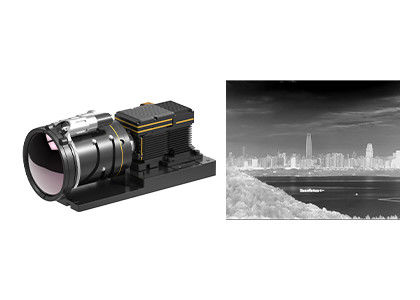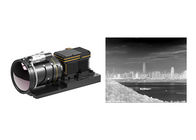-
Thermal Camera Core
-
Thermal Security Camera
-
Drone Thermal Camera
-
EO IR Systems
-
Thermal Imaging Binoculars
-
Infrared Thermal Camera Module
-
High Resolution Thermal Camera Module
-
Cooled Infrared Detectors
-
Optical Gas Imaging
-
Thermal Camera For Fever Detection
-
Cooled Camera Modules
-
Vehicle Mounted Thermal Camera
-
Integrated Dewar Cooler Assembly
-
Uncooled Infrared Detectors
Cooled HgCdTe MWIR Camera Module 640x512 15μm for Handheld Thermal Cameras

Contact me for free samples and coupons.
Whatsapp:0086 18588475571
Wechat: 0086 18588475571
Skype: sales10@aixton.com
If you have any concern, we provide 24-hour online help.
x| Technology | Infrared | Material | MCT |
|---|---|---|---|
| Resolution | 640x512 / 15μm | NETD | ≤20mK |
| Spectral Range | 3.7~4.8μm MW | Size | 125x92x67mm |
| Highlight | HgCdTe MWIR Camera Module,MWIR Camera Module 640x512 |
||
Cooled HgCdTe 640x512 / 15μm RS046 MWIR Thermal Imaging Module for Handheld Thermal Cameras
GAVIN series is the standard cooled infrared module developed by Global Sensor Technology (GST). It is available with different resolution formats, different wave bands and also different continuous optical lens options. GAVIN615B is one of GAVIN series cooled camera module with 640x512 / 15μm MWIR infrared detector and RS046 cryocooler inside.
Various image processing algorithms are already embedded in the GAVIN615B electronics to output clear infrared images in the total darkness or bad weather conditions. It can detect and recognize risks and threats at long distance while present more target details at short distance.
Handheld thermal camera manufacturers prefer this GAVIN615B thermal imaging module just because it provides OEMs with an extremely compact, low power and high performance solution.
- High Sensitivity, NETD≤20mK
- Long Range Detection
- Adjustable Frame Rate
- Easy Integration into the System
| Model | GAVIN615B |
| IR Detector Performance | |
| Resolution | 640x512 |
| Pixel Pitch | 15μm |
| Cryocooler | RS046 |
| Spectral Range | 3.7μm~4.8μm MW |
| Cooling Time (20°C) | ≤7min |
| NETD (20°C) | ≤20mK |
| Image Processing | |
| Frame Rate | 50Hz/100Hz |
| Dimming Mode | Linear/Histogram/Mixed |
| Digital Zoom | ×1/×2/×4 |
| Image Direction | Horizontally/Vertically/Diagonally Flip |
| Image Algorithm | NUC/AGC/IDE |
| Electrical Specification | |
| Standard External Interface | J30JZ 25pin |
| Analog Video | PAL |
| Digital Video | 16bit RAW/YUV: 16bit DVP/Cameralink Output |
| External Sync | Frame External Sync: RS422 Level |
| Communication | RS422, 115200bps |
| Power Supply | 20~28VDC |
| Stable Power Consumption | 12W |
| Dimension (mm) | 125×92×67 |
| Weight | ≤650g |
| Operation Temperature | -40°C ~ +60°C |
| Vibration Magnitude | Vibration: GJB Vehicle-mounted High Speed Transport Shock: Half-sine Wave, 40g 11 ms, 3 Axis 6 Direction 3 Times Each |
| Optical Lens | |
| Optional Lens | Continuous Zoom 60~240mm/F4 15~300mm/F4 21~420mm/F4 35~690mm/F4 |
The GAVIN615B thermal infrared camera module is widely used many areas such as Remote Monitoring System, Flight Vision Enhancement System, Multi-sensor Payload etc.
![]()
![]()
1. How to choose proper infrared detector resolution?
It depends on the actual needs and applications of your products, and the price is also a factor that needs to be considered. If the image quality is not high, you can choose the infrared detector with low resolution, such as 120x90, 256x192, 400x300. If you need a very clear image for some special purposes, such as remote monitoring, you can choose a high resolution infrared detector of 1280x1024.
2. How to select right pseudo color for thermal imaging?
- The gray white is more suitable for the target with small temperature difference
- The red and blue is more suitable for the scene where the problem points need to be found.
- The iron red is the standard color palette of the power industry.
Note: no matter which palette you choose, the thermal temperature will not change at all.
3. How to choose a suitable infrared thermal camera lens?
- Standard lens can meet normal targets with appropriate distance
- For the telephoto lens, it’s suitable for targets that is relatively small and needs to be viewed from a long distance
- To see more detail of objects at close distance, wide angle lens is better.
- Macro lens is for seeing very tinny target with close distance, such as chip circuit.




